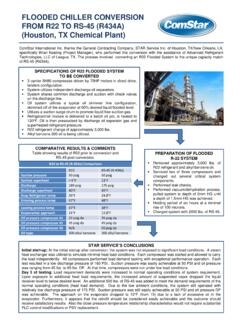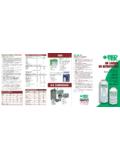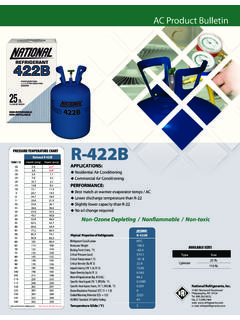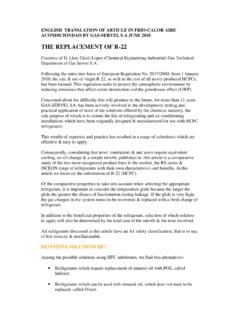Transcription of RS-70 (R453A) - refsols.com
1 RSL Refrigerant Solutions Limited RS-70 ( r453a ) DESCRIPTION Type HFC blend HCFC replacement Temperature glide R22 Approximately 4oC Drop-in or long term Both Lubricant MO/AB/POE ODP Atmospheric lifetime Zero 16 years GWP 100 year ITH 1765 500 year ITH 545 RS-70 : PHYSICAL PROPERTIES RS-70 R22 Molecular weight Boiling point (1 atm) oC 0F (1) (1) Temperature glide oC 0 Critical temperature oC oF Critical pressure bara psia 656 724 Liquid density at 25oC kg/m3 1136 1191 Density of saturated vapour at 25oC kg/m3 Heat capacity of liquid at 25oC kJ/kgoC Ratio of gas heat capacities (cp/cv, k) Vapour pressure at 25oC bara psia (1) 163(1) 151 Latent heat of vaporisation at boiling point kJ/kg 243(1) 234 Ozone Depletion Potential ODP 0 Flammability limit in air (1 atm) vol% None None Inhalation exposure (8 hr day & 40 hr week) ppm 1000 1000 (1) Bubble point 2 TYPE AND DESCRIPTION RS-70 is a non flammable blend which has a zero ODP and is also compatible with both traditional and synthetic lubricants.
2 RS-70 is a suitable replacement for R22 in both refrigeration & air conditioning applications, at low & high temperatures. With its low GWP relative to other refrigerants, RS-70 is an excellent replacement for R22 for use in a wide range of applications. RS-70 can be used as a "Drop-in" replacement for R22 in systems which contain both a fixed orifice or an expansion device. Because there is no need to use expensive and hygroscopic synthetic lubricants, the risk of moisture ingress into a refrigeration system is completely avoided. APPLICATIONS RS-70 is suitable for use in the main applications normally occupied by R22 including commercial air conditioning, cold stores, supermarkets, dairy chillers, refrigerated transport, cellar cooling and others. RS-70 is equally suitable to replace R22 in low & high temperature applications. SERVICE WORK Because it is a blend, it is recommended that RS-70 be charged into systems in the liquid as opposed to the gaseous phase. Since there is no need to change the existing lubricant, RS-70 is straightforward to use as the procedure below outlines.
3 LUBRICANTS RS-70 is compatible with both mineral and alkylbenzene oils found in R22 systems, and also with the polyol ester Therefore, there is no need to change the lubricant although compressor manufacturers' recommendations regarding lubricity should be followed. MATERIALS COMPATIBILITY RS-70 is compatible with all materials commonly used in refrigeration systems previously charged with R22. 3 In general, materials which are compatible with R22 can be used with RS-70 . It is recommended to check equipment manufacturer's retrofit literature and obtain recommendations from equipment manufacturers with regard to materials' compatibility. ENVIRONMENTAL DATA None of the components of RS-70 contains chlorine so that it has no ability to deplete the ozone layer. As with all hydrofluorocarbons (HFCs), RS-70 does have a direct global warming potential (GWP), but this is counterbalanced by the low Total Equivalent Warming Impact (TEWI) of the system.
4 retrofit PROCEDURE The retrofit procedure for replacing R22 with RS-70 is as follows: (1) Ensure the right equipment is available, eg recovery unit and cylinders, container for recovered lubricant, vacuum pump, weighing scales, replacement drier etc. (2) Record baseline data to establish the normal operating conditions for the equipment. (3) Weigh recovered amount of R22 to determine amount of RS-70 to add. (4) Record the amount of oil removed from the compressor since this quantity will need to be recharged. (5) Charge the compressor with lubricant. If in doubt, consult the compressor manufacturer. (6) Replace the filter/drier. (7) Check & replace any seals near the end of their serviceable life & in particular critical seals, eg shaft seals, since some elastomeric seals can be adversely affected by a change from R22 to an HFC (any HFC not just RS-70 ). (8) Having evacuated the system to a full vacuum, liquid charge with RS-70 an amount equal to the original charge of R22.
5 (9) Start the system and adjust the expansion device as required. 4 (10) Avoid overcharging the system. (11) Additional RS-70 may be required but avoid overcharging. If a liquid line sight-glass is fitted, charge to a full glass (small amounts of bubbles in the glass may be normal with refrigerant blends). If the equipment manufacturer recommends charging R22 by evaporator superheat or liquid sub-cooling, use the same amount of superheat or sub-cooling for RS-70 . (12) Carefully monitor the oil level in the compressor & add more oil if required to maintain the correct level. If the oil level does not stabilise & is erratic, some of the oil should be removed from the system & replaced with POE. Adopt the procedure in 12 below. (13) In systems where oil return could be an area of potential concern, eg low evaporating temperatures (-250C & below) containing a liquid receiver, long & complex pipelines, the replacement of up to 25% of the oil charge with a POE is recommended starting with an initial 10% followed by increments of 5% until the oil level stabilises & returns to normal.
6 (14) Check system thoroughly for leaks. (15) Clearly label system RS-70 . NOTE: SYSTEMS WITH INHERENT POOR OIL RETURN, OFTEN WITH UNUSUALLY LONG SUCTION LINES AND/OR LOW TEMPERATURE SYSTEMS, MAY REQUIRE ADDITION OF POLYOL ESTER OIL TO IMPROVE OIL RETURN RS SERIES OF REFRIGERANTS PRESSURE/TEMPERATURE CHARTS RS Series Pressure/Temperature charts indicate both liquid bubble point and vapour dew point of the RS Series Refrigerant. Liquid Bubble Point: this is the temperature which the liquid refrigerant will begin to vaporize at the given pressure. Below this temperature the liquid refrigerant will be sub-cooled. Vapour Dew Point: this is the temperature at which refrigerant vapour will begin to condense at the given pressure. Above this temperature the refrigerant vapour will be superheated. 5 EvaporatorVapour Superheat: To determine evaporator superheat, measure the suction line temperature at the outlet pipe of the evaporator and measure the suction pressure at the outlet pipe of the evaporator.
7 Using the Pressure/Temperature chart, determine the vapour dew point for the measured suction pressure. Subtract the determined dew point from the actual temperature and this difference is the evaporator superheat. Condenser Liquid Sub-Cooling: To determine condenser sub-cooling, measure the temperature of the outlet pipe of the condenser and measure the condenser pressure at the outlet pipe of the condenser. Using the Pressure/Temperature chart, determine the liquid bubble point for the measured condenser pressure. Subtract the measured temperature from the determined bubble point and this difference is the condenser liquid sub-cooling. Note: with the RS Series of low glide blends, the average evaporating and condenser temperatures will be mid-point between the bubble and dew point temperature. 18 November 2013









